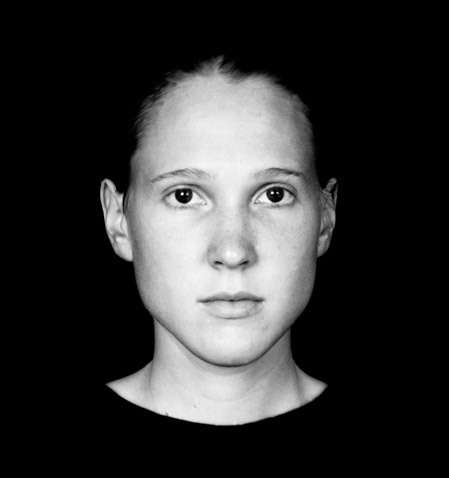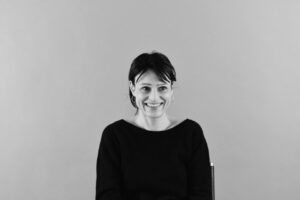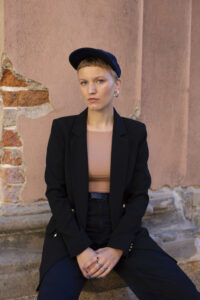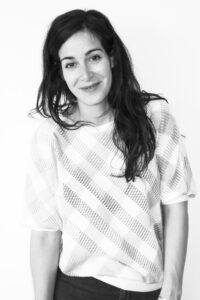Patrícia Kaliczka

– born 1988 – studied at the University of Fine Arts in both Budapest and Lisbon, and graduated in painting in 2013. This same year, she received the Esterházy Art Award. Her complex images reflect on the world’s spatial and temporal interoperability and the combined presence of the conscious and the unconscious. In her works, the synthesis of the journey, the quest for the self, and the peculiar critical declarations, as well as the narratives and painterly happenings on the front of the images, are held together by the background’s abstract structures. Kaliczka lives and works in Basel.
The centre of my interest is the connection between human beings and the cosmos. I investigate the reflection of micro- and microcosms in one another, the essence of energy and substance, the nature and functioning mechanisms of emotion and thought, the roles of transcendence and science and the relationship between the holistic and materialistic worldview. My creative work is closely related to an internal work of self-knowledge and spiritual journey. I use my own experiences as a catalyst in formulating and questioning universal human experiences.
The raw instinct dictated by my feelings and the distilled prudence of thoughts are complementary factors during the painting process. The fierce dynamics of heart-brain dialogue has led to the development of a picturesque language over the years in which the typical practice of abstract and figurative art cannot be distinguished. The conspicuous feature of collage-like spaces is the use of material, colour and composition practices connected to different styles within a work of art.
My paintings are dominated by the relationship between the backgrounds and the figure, complemented by expressive gestures, naturalistic details, blurry collages, wild composition cuts, paraphrases, mythological scenes and symbols that deliberately create a feeling of absence in the viewer.
The underlying, beneath the surface motif of my works is to show the floating, permeable, dynamic quality and interconnections of the spatial and temporal situations of the world.
Painting, my artistic language was not a choice of mine, but rather, a compulsion in a good sense. If I don’t talk through the pictures about what I think and feel about the relationship between the world and humans, the pressure of expression comes out of me in other – mostly negative and destructive – ways. Painting means diverting an inner volcano for me. The research done for my works means inward turning and self-examination, it is an honest relationship with myself12.
About the theoretical inspiration and foundation of my work
The seek after an ultimate truth led me to deal with the idea of the 4th dimension. In the beginning I thought about it as an exterior place; a parallel superior universe, where one could physically go to, let’s say, through a wormhole. Soon I had a clear vision about how I would experience the 4th dimension: I imagined it as if everything would have happened at the same time: in a certain point of space, the forms have ever existed, the ones are existing right now, and those that would ever exist in the future are all presented. They transparently overlap and percolate through one another. From that point, I neither called it the 4th dimension, nor thought of it as a place anymore, but regarded it as a state of mind. A way of experiencing things. As they are in a constant flow3.
How could I make sure this flow is closer to the nature of reality than the static scene that we experience physically, day by day and interpret as ’real world’? In which form had the atoms of the chair I’m sitting on existed a billion years ago? Where will the atoms of my body be and how will they look like two eons from now? What happened throughout the previous centuries in that very point of space where I brush my teeth every morning?
These trains of thoughts were running parallel with my ongoing absorption into Vajrayana Buddhist teachings and a profound meditation practice called ngöndro. While sitting on a cushion on a daily basis, I experienced that my thoughts and feelings are subjected to a constant change, such as any outer phenomena. Later on, having met theories of 20th century physicist David Bohm about the ultimate nature of physical reality has further deepened my interest. Bohm says that the ultimate nature of physical reality is not a collection of separate objects (as it appears to us), but rather it is an undivided whole that is in perpetual dynamic flux.
Bohm also mentions that „the ability to perceive or think differently is more important than the knowledge gained”. The underlying motif which filters through all my work is the permeable, floating and dynamic quality of the spatial and temporal states of the world of which parts are interconnected on several levels. It is not a theme or concept in itself, but my overall approach to life. It remains silent behind the scenes when I’m painting, but it is always present. It works as a subsurface mental attitude when I’m dealing with a topic I am interested in.
I take great pleasure in applying several layers of paint, or handling the figures, objects and spaces in different manner; what I regard as a visual metaphor to our endless layers of thoughts and interpretations which are embedded in even the simplest situation we are faced with456.
The statement was written in cooperation with curator Fruzsina Kigyós (2021).
1Image: Patrícia Kaliczka, Bardo, 2015-2017, oil on canvas, 175 x 159 cm. Courtesy of the artist and Viltin Gallery, Budapest.2Image: Patrícia Kaliczka, Leftover from the last supper, 2014, acrylic, charcoal and oil on canvas, 170 x 157cm. Courtesy of the artist and Viltin Gallery, Budapest.
3Image: Patrícia Kaliczka, Things of the Same Nature, 2015-2017, oil on canvas, 60 x 50 cm. Courtesy of the artist and Viltin Gallery, Budapest.
4Image: Patrícia Kaliczka, Ulysses is Jumping across the White Euphrates, 2015- 2016, oil on canvas, 150 x 174 cm. Courtesy of the artist and Viltin Gallery, Budapest.
5Image: Patrícia Kaliczka, Ritual Trail to Sex, 2019, oil on canvas, 150 x 120 cm. Courtesy of the artist and Viltin Gallery, Budapest.
6Image: Patrícia Kaliczka, Not yet Tilted, 2018, oil on canvas, 60 x 50 cm. Courtesy of the artist and Viltin Gallery, Budapest.
– szül. 1988 – a magyar, valamint a lisszaboni Képzőművészeti Egyetemen tanult, 2013-ban diplomázott festő szakon. Ugyanebben az évben az Esterházy Art Award díjazottja. Komplex képei a világ térbeli és időbeli átjárhatóságára, a tudat és tudattalan együttes jelenlétére reflektálnak. Műveiben az úton levést, az énkeresést, és a markáns kritikai kijelentések szintézisét ugyanúgy, ahogy a képek előterében lezajló narratívákat és festészeti történéseket a háttér absztrakt struktúrái fogják össze. Bázelben él és alkot.
Érdeklődésem középpontjában az emberi lények és a kozmosz közötti kapcsolat áll. Egymásban vizsgálom a mikro- és makrokozmoszt, az energia és az anyag lényegét, az érzelmek természetét és működését, a transzcendencia és a tudomány szerepét, valamint a holisztikus és anyagias világnézet kapcsolatát. Alkotói tevékenységem szorosan összefügg az önismeret területén végzett belső munkával és spirituális úton levéssel. Saját tapasztalataimat használom katalizátorként az egyetemes emberi tapasztalatok megfogalmazásában és megkérdőjelezésében.
Az érzések által diktált nyers ösztön és a gondolatok desztillált óvatossága egymást kiegészítő tényezői a festési folyamatom során. A szív-agy párbeszéd heves dinamikája egy festői nyelv kifejlesztéséhez vezetett az évek során, ahol az absztrakt és figuratív művészet tipikus gyakorlata nem különböztethető meg: a kollázsszerű terek szembetűnő jellemzője a különböző stílusokhoz kapcsolódó anyag-, szín- és kompozíciós gyakorlatok használata egy műalkotáson belül.
Vásznaimat a hátterek és a figura kapcsolata dominálja, mely kiegészül expresszív gesztusok, naturalisztikus részletek, elmosott kollázsok, vad kompozíciós kivágások, parafrázisok, mitológiai jelenetek és a befogadót szándékosan hiányérzetben hagyó szimbólumok használatával. Munkáim felszín alatt meghúzódó közös motívuma a világ térbeli és időbeli helyzeteinek lebegő, átjárható, dinamikus minőségének és összekapcsoltságának megjelenítése.
Alkotói nyelvem, a festészetet nem egy választás, hanem egy jó értelemben vett kényszer. Ha nem beszélek a képeken keresztül arról, amit gondolok és érzek a világ és az ember viszonyáról, akkor egyéb – többnyire negatív és destruktív módon – tör elő belőlem és távozik belőlem a közlés nyomása. Egy belső vulkán mederbe terelése számomra festeni. Az alkotásaimhoz végzett kutatómunka számomra befelé fordulást és önvizsgálatot jelent, azaz az önmagammal való őszinte kapcsolatot jelenti12.
Az alkotás teoretikus inspirációjáról és alapjáról
Az alapvető igazság keresése késztetett arra, hogy a negyedik dimenzió gondolatával foglalkozzak. Kezdetben külső helyként gondoltam rá; egy párhuzamosan felsőbb világegyetemként, ahová fizikailag el lehetne menni, mondjuk egy féregjáraton keresztül. Hamarosan világos elképzelésem lett arról, hogyan tapasztalhatnám meg a negyedik dimenziót: úgy képzeltem el, mintha ott minden egyszerre történne: a tér egy bizonyos pontján a formák valaha léteztek, a formák jelenleg is léteznek, és ezek a jövőben is léteznének. Transzparens módon átfedik és átszűrődnek egymáson. Ettől a ponttól kezdve nem neveztem a negyedik dimenziónak, és nem is gondoltam rá többé térként, hanem úgy, mint egy elmeállapotra. Inkább a dolgok megtapasztalásának módja ez. Ahogyan egy állandó flowban van3.
Hogyan tudnék megbizonyosodni arról, hogy ez az áramlás közelebb áll a valósághoz, mint egy statikus jelenet, amelyet fizikailag és napról napra átélünk és „valós világként” értelmezünk? Milyen formában léteztek billió évvel ezelőtt a szék atomjai, amin ülök? Hol lesznek testem atomjai, és hogyan fognak kinézni két eonként? Mi történt az előző évszázadok során azon a ponton, ahol minden reggel fogat mosok?
Ezek a gondolatmenetek párhuzamosan futottak Vadzsrajána buddhista tanításai és ngöndro mély meditációs gyakorlatok alatt. Miközben napi szinten egy párnán ültem, megtapasztaltam, hogy gondolataim és érzéseim olyanok, mint egy állandó változás, mint bármely külső jelenség. Később, miután találkoztam David Bohm XX. századi fizikus elméleteivel a fizikai valóság végső természetéről, tovább mélyült az érdeklődésem. Bohm azt mondja, hogy a fizikai valóság végső természete nem különálló tárgyak gyűjteménye (ahogy nekünk is tűnik), hanem inkább egy teljesen osztatlan, állandó mozgásban lévő tárgy.
Bohm megemlíti azt is, hogy „a másképp észlelés vagy gondolkodás képessége fontosabb, mint a megszerzett tudás”. Az összes motívum, amely a vásznaimon átszűrődik, a világ térbeli és időbeli állapotainak átjárható, lebegő és dinamikus minősége, melynek részei több szinten kapcsolódnak egymáshoz. Ez önmagában nem egy téma vagy koncepció, hanem az általános életszemléletem. Néma marad a színfalak mögött, amit festek, de mindig jelen van. Egy felszín alatti mentális attitűdként működik, ha olyan témával foglalkozom, ami vonz456.
A statement Kaliczka Patrícia és Kigyós Fruzsina kurátor együttműködésében jött létre (2021).
1Kép: Kaliczka Patrícia, Bardo, 2015-17, olaj, vászon 175 x 159 cm. A művész és a Viltin galéria jóvoltából.2Kép: Kaliczka Patrícia, Az utolsó vacsora maradéka, 2014, olaj, vászon, 170 x 157 cm. A művész és a Viltin galéria jóvoltából.
3Kép: Kaliczka Patrícia, Azonos természetű dolgok, 2015-2017, olaj, vászon, 60 x 50 cm. A művész és a Viltin galéria jóvoltából.
4Kép: Kaliczka Patrícia, A fehér Eufráteszt átugró Odüsszeusz, 2015-2016, olaj, vászon, 174 x 150 cm. A művész és a Viltin galéria jóvoltából.
5Kép: Kaliczka Patrícia, Rituális nyom a szex felé, 2019, olaj, vászon, 150 x 120 cm. A művész és a Viltin galéria jóvoltából.
6Kép: Kaliczka Patrícia, Még nincs címe, 2018, olaj, vászon, 60 x 50 cm. A művész és a Viltin galéria jóvoltából.



